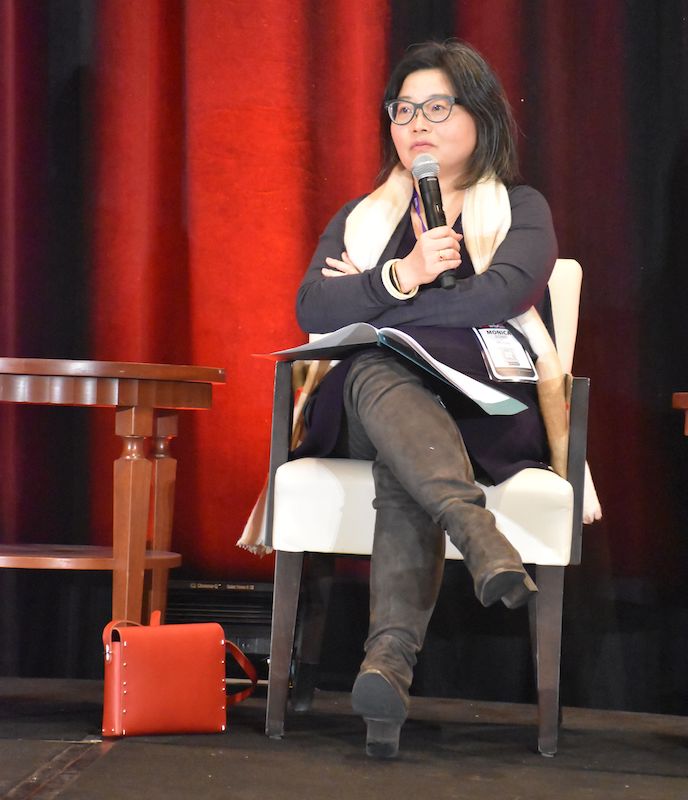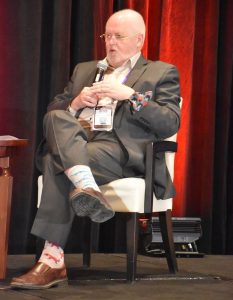
By Christopher Guly
GATINEAU – Telecom regulation should be carved out of the CRTC’s mandate, said a former commissioner on a panel looking at “what’s next in telecom” at the 10th annual Canadian Association of Wireless Internet Service Providers (CanWISP) conference at the Hilton Lac-Leamy in Gatineau, Quebec today.
“We should have a Canadian communications commission based around the idea that the internet is the basic communication method going forward,” said former journalist Peter Menzies (pictured below), a senior fellow of the Macdonald-Laurier Institute who served as vice-chair of telecommunications at the CRTC.
In its final report on Canada’s communications future, released in January 2020, the Broadcasting and Telecommunications Legislative Review (BTLR) Panel recommended “that the name of the CRTC be changed to the Canadian Communications Commission.”
“Its current name – the Canadian Radio-television and Telecommunications Commission – is out of step in a world that has moved beyond conventional radio and television stations, and in which telecommunications now encompasses a wide range of electronic communications,” the report said.
Menzies would rather see Innovation, Science and Economic Development Canada (ISED) “take more of an assertive role in the telecom area.”
“It makes no sense whatsoever to have the telecom regulator reporting to [Canadian] Heritage [that] views everything through a cultural lens. When they look at the CRTC, they see broadcasting – and when people in government want to appoint a commissioner to the CRTC, they think culture and heritage, but nobody really has a strength in telecom,” said Menzies.
“We are at a point in time where we need to separate the economic principles for telecom carriage, however they may be accomplished, from the cultural-broadcasting objectives” – Christian Tacit, founder of Tacit Law
“And now, because [the CRTC is] going to be lords and masters over the internet, you’re going to have to have people who know a lot about the internet.”
Christian Tacit, who runs an Ottawa boutique law firm that provides legal services in the information technology and communications industries, agreed with the need for some CRTC commissioners to have a telecom background – people who are either in the industry or who have [experience in] other relevant disciplines – economics, competition law, privacy – the things that are important to a telecom mandate, [but that] are largely missing.”
Menzies pointed to the dominance of telecom over broadcasting by the numbers.
“Telecom is a $70 billion-a-year industry and growing,” he offered. “Broadcasting industry is a $19 billion-a-year industry and shrinking.”

Menzies punctuated his point by recalling his time as a CRTC commissioner.
“There used to be broadcast committee meetings immediately followed by telecom committee meetings,” he said. “You could spend two hours having passionate debates over the failure of a small religious radio station in Montreal to pay a $4,000 Canadian-content development obligation – and we’d be exhausted by that, and go into the telecom committee meeting and there was a $100-million decision and everybody was like ‘whatever’ – and that’s just institutionally wrong.”
Tacit agreed with Menzies about a disconnect involving CRTC oversight of telecom regulation.
“We are at a point in time where we need to separate the economic principles for telecom carriage, however they may be accomplished, from the cultural-broadcasting objectives,” he said. “I think it may be time to have separate regulators for those two functions.”
“Heritage would be responsible for a broadcasting commission, and an independent telecom body would report to ISED,” Tacit explained.
“Each of the departments would be able to issue policy directives to its independent tribunal. It would be the department, not cabinet, because it would be a less political process and more based on policy issues,” he said.
“If you’re going to have things that need to be calibrated over time, the way to do it is to get them from ISED to the regulator. Politicizing them through policy directions is not a good route because it becomes something watered down that pleases nobody and doesn’t mean anything.”
With the CRTC, Tacit would like to see time limits imposed on the commission’s decision-making process and have commissioners “sign their names” on their rulings.
Menzies said regulators, such as the CRTC, “need to be trusted,” through, he suggested, “more transparency.”
“The experience of smaller ISPs has been disappointing to say the least” – Monica Song, partner, Dentons Canada LLP
One way to achieve that would be to release minutes from CRTC meetings to allow members of the telecom industry to read about the deliberations, learn what arguments were presented, and know which commissioner spoke – or not.
“You could be a commissioner at the CRTC and go to meetings for four years, five years, and never say a word – and nobody would know,” said Menzies.
He would also like to see CRTC commissioners visit more communities, particularly in remote and rural areas “to see what the challenges are in communications,” and have that travel component a requirement for the role.
“You don’t really know what rural and remote is until you try to log onto the internet in Iqaluit,” said Menzies.
On the issue of assigning mobile and terrestrial spectrum, the auction model might not be the right one in rural and remote areas, said Monica Song (above), a partner with Dentons Canada LLP who leads the communications and regulatory practices in the law firm’s Ottawa office and who served on the BTLR panel.
“The experience of smaller ISPs has been disappointing to say the least,” she said, noting “ISED policies have been framed around competition and the rapid deployment of spectrum.”
Song also urged wireless ISPs to prepare for the next outlook – for 2023 to 2028.
“That consultation paper is not out yet, and this is the kind of thing that an organization like CanWISP should be thinking about ahead of time,” she said.



